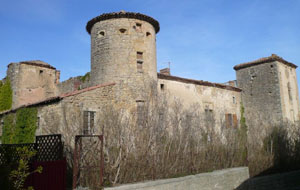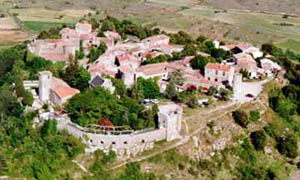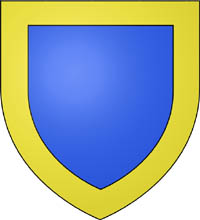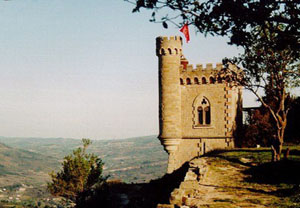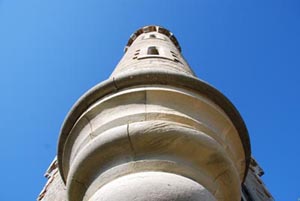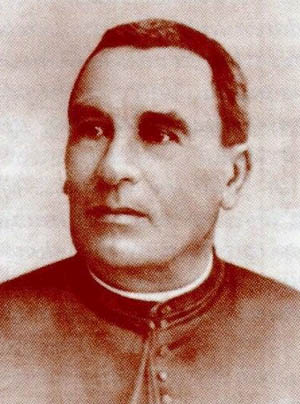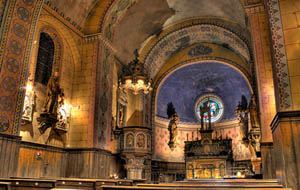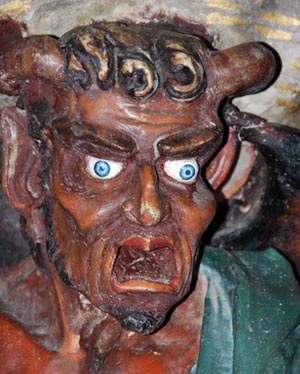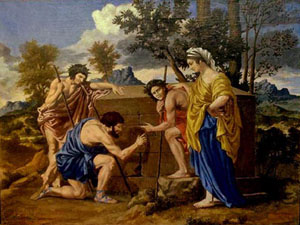Rennes-le-Chateau |
|
|
Rennes-le-ChateauRennes-le-Château (or Rennes le Château) is a village and commune in the Aude department in the Languedoc in southern France. It overlook the valey of the River Salz, opposite a Cathar Castle called Coustaussa. The population of Rennes is around 100. This tiny village is at the centre of various conspiracy theories, and receives tens of thousands of visitors per year. There is a privately owned chateau at Rennes-le-Chateau, but this chateau has little connection with the theories, except that it was home to the Hautpoul family who were allegedly involved in these conspiracies in earlier centuries. Rennes le Chateau is so named to distinguish it from its sister village Rennes les Bains. In Occitan Rennes-le-Chaeau is called Rènnas del Castèl. In Roman times it was known as Rheada.
The area is known for beautiful scenery, with jagged ridges, deep river canyons and rocky limestone plateaus, with large caves underneath. Mountains frame the region, les Montaines Noires to the north, the Corbieres to the west, the Plateau de Sault to the east, and the Pyrenees to the south. Rennes-le-Château has a complex history. It is the site of a prehistoric encampment, and later a Roman colony called Rheada. Rennes-le-Château was a Visigoth site during the 6th and 7th centuries, during the trying period when the Visigoths had been defeated by the Frankish King Clovis I and had been reduced to Septimania. It was the administrative centre of the County of Razès, a fief of the Counts (later viscounts) of Carcassonne and Beziers. The village was the site of a medieval castle around 1002, though nothing remains above ground of this medieval structure (the present chateau dates from later in the Middle Ages). Several castles situated in the surrounding region in the Languedoc were central to the Catholic Church's Crusade against and extirpation of the Cathars at the beginning of the 13th century. Thousands were killed during the campaigns of the Catholic authorities to rid the area of the Cathar heretics during the Albigensian Crusade (aka Cathar Wars) and again when Huguenots (French Protestants) fought for religious freedom against the French monarchy. A church in the town also has a complex history, having been rebuilt several times. The earliest church of which there is any evidence on the site may date to the 8th century. This original church was almost certainly already in ruins during the 10th or 11th century, when another church was built on the site - remnants of which can be seen in Romanesque pillared arcades on the north side of the apse. This second church building survived in poor repair until the 19th century, when it was renovated by the village priest, Abbé Bérenger Saunière. Despite the village's tiny size over 100,000 tourists each year. Much of the modern reputation of Rennes-le-Château rises from rumours dating from the mid-1950s concerning the local 19th-century priest. Abbé Bérenger Saunière had arrived in the village in 1885, and had acquired and spent large sums of money during his tenure from selling masses and receiving donations. He funded several building projects, including an extensive renovation of the Church of Mary Magdalene. The source of the wealth had long been a topic of conversation, with village rumours ranging from the idea that the priest had found a treasure (possibly by grave robbing) to the possibility that he had been spying for the Germans during World War I. During the 1950s, these rumours were given wide local circulation by Noël Corbu, a local man who had opened a restaurant in Saunière's former estate (L'Hotel de la Tour). Corbu hoped to use the stories to attract business. Corbu also claimed that Rennes-le-Château was the capital of the Visigoths, but this was an exaggeration, though Rennes had certainly declined in importance over a millenium. His claim can be traced back to an anonymous document - actually written by Nöel Corbu himself - entitled L'histoire de Rennes-le-Château, which was deposited at the Departmental Archives at Carcassonne on 14 June 1962. His assertion of the Visigothic importance of Rennes-le-Château was drawn from one source: A monograph by Louis Fédié, entitled Rhedae, La Cité des Chariots, published in 1876 (still in print). Fédié's assertions concerning the population and importance of Rennes-le-Château have since been contradicted by archaeology and the work of more recent historians. Because of the claims by Corbu, Rennes-le-Château became the centre of conspiracy theories about Saunière's mysterious wealth. The story grew in the telling, from the initial rumours that perhaps he had uncovered hidden treasure, to speculation that he had discovered secrets about the history of the Church, which could threaten the foundations of the Catholic Church. The entire area around Rennes-le-Chateau has become the focus of increasingly sensational claims involving the Knights Templar, the Priory of Sion, the Rex Deus, the Holy Grail, the Knights Templar and the treasures of the Temple of Solomon, the Ark of the Covenant, ley lines, Cathars, Montségur (another Cathar Castle), Druids, Jesus, Mary Magdelene, space aliens and sacred geometry. Noël Corbu's claim, designed to attract visitors to his local hotel in the 1950s, was that Abbe Saunière had become rich by finding a royal treasure inside one of the pillars in his church in the late 19th century. Newspapers started printing Corbu's story in 1956. This ignited a flame and visitors with shovels flooded the town. Corbu's restaurant flourished. The story attracted large numbers, including one Pierre Plantard. Plantard's childhood dream had been to play a vital role in the history of France, so he and some friends concocted an elaborate hoax. It involved planting fabricated documents in France's Bibliothèque nationale de France to imply that Plantard was a descendant of a French royal dynasty, and indeed heir to the crown of France. Fabricated documents mentioned the ancient Priory of Sion, supposedly a thousand years old, but in fact founded by Plantard himself in 1956 with three of his friends. No serious journalists who investigated the story found it plausible enough to write about, so Plantard asked his friend, Gérard de Sède, to write a book to give more credence to the story. They chose the already rumour-rich area of Rennes-le-Chateau as their setting, and L'Or de Rennes (The Gold of Rennes, later published as Le Trésor Maudit de Rennes-le-Château) came out in 1967 and was an instant success. Already a special by-law, passed in 1965, prohibbited digging in the village, treasure hunters having been stimulated into action even before the book's publication. The book presented Latin documents forged by Plantard's group, alleging that these were medieval documents that had been found by Saunière in the 19th century. One of the documents contained encrypted references to the Priory of Sion, thereby attempting to prove that the society was older than its actual creation date of 1956. In 1969, a British actor and writer by the name of Henry Lincoln read the book, dug deeper, and wrote his own books on the subject, pointing out his discovery of hidden codes in the parchments. One of the codes involved a series of raised letters in the Latin message, which when read off separately, spelled out in French: a dagobert ii roi et a sion est ce tresor et il est la mort. (This treasure belongs to King Dagobert II and to Sion, and it [or he] is death.). Lincoln created a series of BBC Two documentaries about his theories in the 1970s, and then in 1982, co-wrote The Holy Blood and the Holy Grail with Michael Baigent and Richard Leigh. Their book expanded upon the Rennes-le-Château story to further imply that the descendents of Jesus and Mary Magdelane were connected to the French royalty, as perpetuated through a secret society named the Priory of Sion. This torch was picked up and carried further in 2003 in Dan Brown's bestselling novel The Da Vinci Code. Brown's book never specifically mentioned Rennes-le-Château, but some key characters in the book had related names, such as Sauniere, named after the priest, a man called Le Bezu (taken from a nearby Cathar Castle also called Le Bézu) and "Leigh Teabing", whose first name was derived from Richard Leigh, and last name, Teabing, was an anagram of Baigent.
The "Visigothic pillar" where Sauniere was said to have found the documents is on display in the village's Saunière Museum. The pillar was set up by Saunière in 1891 as part of his shrine to Our Lady of Lourdes, though there is some dispute as to whether the pillar actually originated from Saunière's church. A Church report drawn up by the diocesan architect Guiraud Cals in 1853 failed to mention the existence of any altar pillar. When investigated more rigorously, the stories of Abbé Bérenger Saunière's mysteries were based on a scandal involving the sale of masses, which eventually led to the disgrace of both Saunière and his bishop. Saunière's wealth was short-lived, and he died relatively poor. Official records of a trial against Saunière on August 23, 1910 revealed his fortune at the time to have been 193,150 francs, which he claimed to be spending on parish works. Yet, in order to have gained this wealth through the selling of masses, the priest would have had to sell over 20 masses per day for the 25 years prior to the trial, more than he could have performed. Sauniere claimed that he performed masses for which he was paid and that other funds came from local donations. This evidence was published by French Editions Belisane from the early 1980s onwards, with evidence from the archives in the possession of Antoine Captier, including Saunière's correspondence and notebooks. Minutes of the ecumenical trial between Saunière and his bishop between 1910-1911 are located in the Carcassonne Bishopric. The source of Saunière's wealth was not ancient treasure, but fraud. hilippe de Chérisey - who helped Plantard with his fraud - admitted having fabricated the historical documents. The decoded messages embedded within the forged documents were shown to have been written in modern French. Gérard de Sède, another of the conspirators who had written the book Le Tresor Maudit, also wrote a book denouncing the fraud.
The Church of May Magdelene at Rennes-le-ChateauThe origin of Abbé Bérenger Saunière's funds at the time was controversial and some of the additions to the church appear unusual to the modern eye. One of the new features was an inscription above the front door of the church: Terribilis est locus iste (This is a place of awe). Inside the church, one of the added figures was of a demon holding up the holy water stoup, a rare feature in a French church. Figures and statues are sometimes claimed to contain various strange and significant features, but it is known that they were chosen by Saunière from a catalogue published by Giscard, sculptor and painter in Toulouse who - among other things - offered statues and sculptural features for church refurbishment. Abbé Bérenger Saunière also funded the construction of another structure dedicated to Mary Magdalene. Named after his church, he built a nearby tower which he used as his library. The tower has a promenade linking it to the Villa Bethanie. The inscription above the entrance of the church is taken from the Common Dedication of a Church, which in full reads "This is a place of awe; this is God's house, the gate of heaven, and it shall be called the royal court of God." [Cf. Gen 28:17]: The first part of the passage is situated in the entrance of the church - the rest of the passage is actually inscribed over the arches on the two doors of the church. Following Saunière's renovations and redecoratations, the church was re-dedicated in 1897 by his bishop, Monsignor Billard.
|
|
||||||||||||||||||||||||||||||||||
|
|
|
|
||||||||||||||||||||||||||||||||||
|
|
|||||||||
| :::: Link to us :::: Castle and Manor Houses Resources ::: © C&MH 2010-2014 ::: contact@castlesandmanorhouses.com ::: Advertising ::: |


